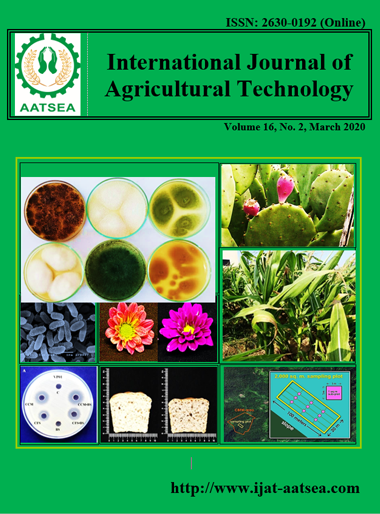Degradation of heavy metal contaminated soil using plant growth promoting rhizobacteria (PGPR): Assess their remediation potential and growth influence of Vigna radiata. L
Main Article Content
Abstract
The contamination of heavy metal is caused by the natural and anthropogenic source which a global environment. The remediation of heavy metal- contaminated soil has faced a critical issue due to toxic effects on living organisms. The heavy metal-tolerant plant growth promoting rhizobacteria (PGPR), Pseudomonas fluorescens (PF01), and Bacillus subtilis (BS01) revealed to alleviate the heavy metal’s toxic effects on the Green gram plant (Vigna radiata, L.) and their abilities to promote plant growth in greenhouse. The growth performance, photosynthetic pigments, heavy metal uptake were presented in green gram cultivated in the soil of contaminated with heavy metals under the greenhouse conditions. Results showed that the application of PGPR strains as a biofertilizer to green gram that helped the plant to ignore the toxic effects of heavy metals and enhanced the plant growth characteristics.
Article Details

This work is licensed under a Creative Commons Attribution-NonCommercial-NoDerivatives 4.0 International License.
References
Altschul, S. F., Maddan, T. L., Schaffer, A. A., Zang, J., Zang, Z., Miller, W. and Lipman, D. J. (1997). Gapped BLAST and PSI-BLAST: a new generation of protein database search programmes. Nuclic Acids Research, 25:3389-3402.
Allen, S. E, Grimshaw, H. M. and Rowland, A. P. (1976). Chemical analysis. In-Chapmen, S. B (Ed.), Methods in plant ecology. Blackwell Scientific Publications, Ox-fard-London, pp.335-335.
Arnon, D. (1949). Copper enzymes in isolated chloroplasts, polyphenol oxidase in Beta valgaris. Plant Physiology, 24:1-15.
Bauer, A. W., Kirby, W. M. M., Sherries, J. C. and Twick, M. (1966). Antibiotic susceptibility testing by a standardized single disc method. American journal of clinical Pathalolgy, 45:493-496.
Bhardwaj, D., Ansari, M., Sahoo, R. and Tuteja, N. (2014). Biofertilizers function as key player in sustainable agriculture by improving soil fertility, plant tolerance and crop productivity. Microb Cell Factories, 13:66-76.
Cappuccino, J. G. and Sherman, N. (2002). Microbiology; a laboratory manual (8th edition). Pearson. ISBN-13:978.
Cervantes-Vega, C., Chávez, J., Córdova, N. A., de la Mora, P. and Amador Velasco, J. (1986). Resistance to metals by Pseudomonas aeruginosa clinical isolates. Microbios, 48:159-163.
Chen, Y. P., Rekha, P. D., Arun, A. B, Shen, F. T., Lai, W. A. and Young, C. C. (2006). Phosphate solubilizimg bacteria from subtropical soil and their tricalcium phosphate solubilizing abilities. Applied soil Ecology, 34:33-41.
Cheng, S. (2003). Effect of heavymetals on plants and resistance mechanisms- A state of the art report with Special reference to literature published in chinese journals. ESPR- Environ Science&Pollution Research, 10:256.
Dastager, S. G, Deepa, C. K. and Pandey, A. (2011). Potential plant growth-promoting activity of Serratia nematodiphila NII- 0928 on black pepper (Piper nigrum. L.). World Journal of Microbiology Biotechnology, 27:259-265.
Dutta, P., Karmakar, A., Majumdar, S. and Roy, S. (2018). Klebsiellapneumoniae (HR1) assisted alleviation of Cd (II) toxicity in Vigna mungo: a case study of biosorption of heavy metal by an endophytic bacterium coupled with plant growth promotion. Euro-Mediterranean Journal for Environmental Integration, 3:27.
Govindarajan, M., Balandreau, J., Muthukumarasamy, R., Revathi, G. and Lakshminarasimhan, C. (2006). Improved yield of micro propagated sugarcane following inoculation by endophytic Burkholderia vietnamiensis. Plant and soil, 280:239-252.
Govindasamy, C., Arulpriya, M., Ruban, P., Francisca, L. J. and Ilayaraja, A. ( 2011). Concentration of heavy metals in seagrasses tissue of the Palk Strait, Bay of Bengal. International journal of environmental sciences, 2:145-153.
Han, H, Sheng, X., Hu, J., He, L. and Wang, Q. (2018). Metal-immobilizing SerratialiquefaciensCL-1 and Bacillus thuringiensisX30 increase biomass and reduce heavy metal accumulation of radish under field conditions. Ecotoxicology and Environmental Safety, 161:526-533.
Jha, Y. and Subramanian, R. B. (2016). Rhizobacteria enhance oil content and physiological status of Hyptissuaveolensunder salinity stress. Rhizosphere, 1:33-35.
Kamran, M. A., Syed, J. H., Eqani, S. A. M. A. S., Munis, M. F. H. and Chaudhary, H. J. (2015). Effect of plant growth-promoting rhizobacteria inoculation on cadmium (Cd) uptake by Eruca sativa. EnvironmentalScienc.Pollutant.Research, 22:9275-9283.
Mlezeck, M., Rutkowski, P., Rissmann, I., Kaczmarek, Z., Golinski, P., Szentner, K., Strazynska, K. and Stachowiak, A. (2010). Biomass productivity and phytoremediation potential of Salixviminalis. Biomass Bioenegry, 34:1410-1418.
Parnell, J. J., Berka, R., Young, H. A., Sturino, J. M., Kang, Y., Barohart, D. M. and DoLeo, M. V. (2016). From lab to the farm” an industrial perspective of plant beneficial microorganisms. Frontiors plant science, 7:1110.
Rajkumar, M., Sandhya, S., Prasad, M. N. V. and Freitas, H. (2012). Perspectives of plant associated microbes in heavymetal phytoremediation. Biotechnology Advances, 30:1562-1574.
Schwyn, B. and Neilands, J. (1987). Universal chemical assay for the detection and determination of siderosphores. Analytical Biochemistry, 160:47-56.
Seneviratne, M., Seneviratne, G., Madawal, H. and Vithanage, M. (2017). Role of Rhizospheric Microbes in Heavymetal uptake by plants, In:Singh J, Seneviratne G(EDS)Agro-Environmental sustainability. Springer, pp.147-163.
Sowmya, M., Rejula, M. P., Rejith, P. G., Mahesh, M. M., Makesh, K. M. and Mohamed Hath, A. A. (2014). Heavy metal tolerant halophilic bacteria from Vembanad Lake as possible source for bioremediation of lead and cadmium. Journal of Environmental Biology, 35:655-660.
Tein, T. M., Gaskins, M. H. and Hubbell, D. H. (1979). Plant growth substances produced by Azospirillumbrasilense and their effect on the growth of pearl millet (Pennisetumamericanum L.). Applied Environmental Microbiology, 37:1016-1024.
Treesubsuntorn, C., Dhurakit, P., Khaksar, G. and Thiravetyan, P. (2018). Effect of microorganisms on reducing cadmium uptake and toxicity in rice (Oryza sativa L.). Environmental Science Pollutant Research, 25:25690-25701.
Vincent, M. J. (1970). A manual for the partical study of root nodule bacteria. Blackwell scientific, Oxford. pp. 1-3.


